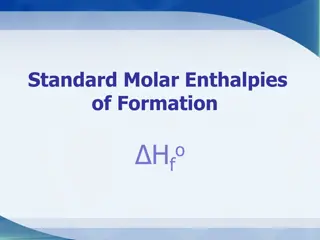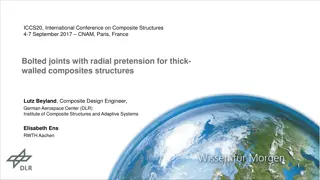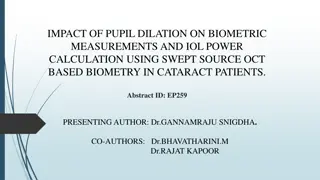Understanding Thick Lens and Image Formation Calculations
Explore the concept of thick lenses, the parallel-ray method for locating images, and the application of general formulas for calculating image distances in the context of two spherical surfaces formed by a thick lens. An example problem involving an equiconvex lens and refractive indices for air, glass, and water is also illustrated.
Download Presentation

Please find below an Image/Link to download the presentation.
The content on the website is provided AS IS for your information and personal use only. It may not be sold, licensed, or shared on other websites without obtaining consent from the author. Download presentation by click this link. If you encounter any issues during the download, it is possible that the publisher has removed the file from their server.
E N D
Presentation Transcript
Thick lens Lect.2
TWO SPHERICAL SURFACES formed by a thick lens and then apply the general formulas already given for calculating image distances. The formulas to be used are
We shall first consider the parallel-ray method for graphically locating an image formed by a thick lens and then apply the general formulas already given for calculating image distances. The formulas to be used are :
The parallel-ray method of graphical construction, applied to a thick lens of two surfaces, is shown in Fig. 5B. Although the diagram is usually drawn as one, it has been separated into two parts here to simplify its explanation. The points F1 and F1 represent the primary and secondary focal points of the first surface, and F2' and F2 represent the primary and secondary focal points of the second surface, respectively.
EXAMPLE I An equiconvex lens 2 cm thick and having radii of curvature of 2 cm is mounted in the end of a water tank. An object in lens 5 cm from its vertex. Find the refractive indices of 1.00, 1.50, and 1.33 for air, glass, and water, respectively air is placed on the axis of the position of the final image. Assume SOLUTION The relative dimensions in this problem are approximately those shown in Fig. 5B(b). If we apply Eq. (Sa) to the first surface alone, we find the image distance to be
When the same equation is applied to the second surface, we note that the object distance is s;' minus the lens thickness, or 28 cm, and that since it pertains to a virtual object it has a negative sign. The substitutions to be made are, therefore, S2 = -28 em, n' = 1.50, n" = 1.33, and r2 = -2.0 cm.
The incident rays in the glass belong to an object point M', which is virtual, and thus S2, being to the right of the vertex A2, must also be negative. The final image is formed in the water (n" = 1.33) at a distance +9.6 cm from the second vertex. The positive sign of the resultant signifies that the image is real. It should be noted that Eqs. (Sa) hold for paraxial rays only. The diagrams in Fig. 5B, showing all refraction as taking place at vertical lines through the vertices Ai and A2, are likewise restricted to paraxial rays.
Diagrams showing the characteristics of the two focal points of a thick lens are given in Fig. 5C. Transverse planes through these intersections constitute primary and secondary principal planes. These planes cross the axis at points Hand H", called the principal points.
If the media on the two sides of the lens are different so that n" is not equal to n, the two focal lengths are different and have the ratio of their corresponding refractive indices: In general the focal points and principal points are not symmetrically located with respect to the lens but are at different distances from the vertices. he construction procedure follows that given in Fig. 4M for a thin lens, except that here all rays in the region between the two principal planes are drawn parallel to the axis. the object and image distances are measured to or from the principal points, we can apply the gaussian lens formula
CONJUGATE RELATIONS In the special case where the media on the two sides of the lens are the same, so that n" = n, we find!" = land Eq. (5c) becomes Figure 5F shows that for the purposes of graphical construction the lens may be regarded as replaced by its two principal planes. Often the image distance is the unknown, and Eq. (5c) can be written in the more useful form
THE OBLIQUE-RAY METHOD The oblique-ray method of construction may be used to find graphically the focal points of a thick lens. As an illustration, consider a glass lens of index 1.50, thickness 2.0 cm, and radii T1 = +3.0 cm, T2 = -5.0 cm, surrounded by air of index n = 1.00.
A set of formulas that can be used for the calculation of important constants generally associated with a thick lens is presented below in the form of two equivalent sets.
These equations are derived from geometrical relations that can be obtained from a diagram like Fig. 5G. As an illustration, the gaussian equation (5k) is derived as follows. From the two similar right triangles T1A1F1 and T2A2F2 we can write corresponding sides as proportions and, from the two similar right triangles N"H"F" and T2A2F", we can write the proportions 1 the neutralizing power. Pn = the reciprocal of Eq. (5h) to obtain ?1?. Calling Pn the neutralizing power, we can take
EXAMPLE 2 A lens has the following specifications: r1 = + 1.5 cm, r2 = . + 1.5 cm, d = 2.0 cm, n = 1.00, n' = 1.60, and n" = 1.30. Find (a) the primary and secondary focal lengths of the separate surfaces, (b) the primary and secondary focal lengths of the system, and (c) the primary and secondary principal points. SOLUTION (a) To apply the gaussian formulas, we first calculate the individual focal lengths of the surfaces by means of Eq. (5f).

























